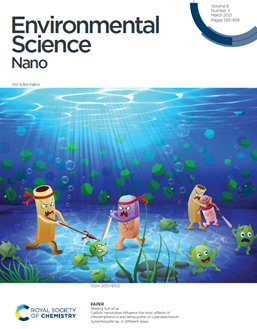博士生尤明涛在Environmental Science: Nano 发表碳纳米管和抗生素对蓝藻复合毒性的封面文章
天然水体中多种污染物的复合污染普遍存在,不同污染物之间会发生相互作用,进而改变污染物的环境行为和生态效应。本研究探讨了碳纳米管与抗生素(氯霉素(CAP)和四环素(TC))对蓝藻(Synechocystis sp. PCC 6803)的联合毒性效应,并采用ROS淬灭、细胞膜通透性、胞内元素分布和蛋白组学分析等手段剖析了碳纳米管和抗生素的复合毒性机制。

研究发现ROS引起的氧化损伤是CNTs对蓝藻的致毒机制之一,而对抗生素导致的细胞死亡没有贡献。CNTs与CAP的联合毒性为加和效应,而与TC的联合毒性为拮抗效应,这是因为碳纳米管对TC的强吸附作用和催化降解降低了溶液中TC的含量。CNTs显著上调光合作用。CAP显著抑制蛋白质合成,导致细胞体积变小。TC显著下调与细胞壁合成相关的周质空间蛋白,从而导致细胞壁严重破坏。
研究揭示了碳纳米管和抗生素复合污染毒性效应的分子机制,并发现水环境中不同污染物之间相互作用会导致其联合毒性效应的差异。研究结果可为天然水体中多种污染物复合污染的潜在生态危害和环境风险评价提供理论依据。
相关文献:You MT, You XQ, Hu JR, Yang X, Sun WL*, Carbon nanotubes influence the toxic effects of chloramphenicol and tetracycline to cyanobacterium Synechocystis sp. in different ways, Environmental Science: Nano, 2021, 8, 634-646.
Environmental significance
Compared with previous studies focused on the effect of CNTs or antibiotics on aquatic organisms, our efforts were mainly devoted to the combined effect of CNTs and antibiotics on cyanobacterium Synechocystis sp. PCC 6803 to reveal the influencing mechanism of CNTs on the toxicity of antibiotics. CNTs exhibited an additive effect with CAP but an antagonistic effect with TC. Moreover, this study provides direct evidence for the molecular mechanisms of proteomic perturbations in Synechocystis sp. exposed to CNTs and/or antibiotics. This study provides a new insight into the molecular mechanisms of combined toxicity of multiple pollutants to cyanobacterium.
